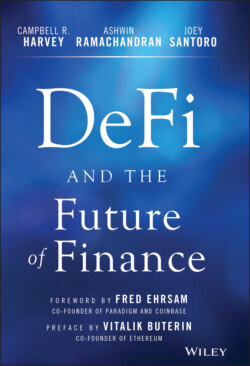Читать книгу DeFi and the Future of Finance - Campbell R. Harvey - Страница 14
BLOCKCHAIN
ОглавлениеThe key to all DeFi is the decentralizing backbone: a blockchain. Fundamentally, blockchains are software protocols that allow multiple parties to operate under shared assumptions and data without trusting each other. These data can be anything, such as location and destination information of items in a supply chain or account balances of a token. Updates are packaged into “blocks” and are “chained” together cryptographically to allow an audit of the prior history – hence the name.
Blockchains are possible because of consensus protocols – sets of rules that determine what kinds of blocks can become part of the chain and thus the “truth.” These consensus protocols are designed to resist malicious tampering up to a certain security bound. The blockchains we focus on currently use the proof of work (PoW) consensus protocol, which relies on a computationally and energy intensive lottery to determine which block to add. The participants agree that the longest chain of blocks is the truth. If attackers want to make a longer chain that contains malicious transactions, they must outpace all the computational work of the entire rest of the network. In theory, they would need most of the network power (“hash rate”) to accomplish this – hence, the famous 51 percent attack being the boundary of PoW security. Luckily, it is extraordinarily difficult for any actor, even an entire country, to amass this much network power on the most widely used blockchains, such as Bitcoin or Ethereum. Even if most of the network power can be temporarily acquired, the amount of block history that can be overwritten is constrained by how long this majority can be maintained.
As long as no malicious party can acquire majority control of the network computational power, the transactions will be processed by the good faith actors and appended to the ledger when a block is “won.”
The focus here is on proof of work, but many alternative consensus mechanisms exist, the most important of which is proof of stake (PoS). Validators in PoS commit some capital (the stake) to attest that the block is valid and make themselves available by staking their cryptocurrency. Then, they may be selected to propose a block, which needs to be attested by many of the other validators. Validators profit by both proposing a block and attesting to the validity of others’ proposed blocks. PoS is much less computationally intensive and requires vastly less energy.
